Amphibious Cars: Blurring the Lines Between Land and Water
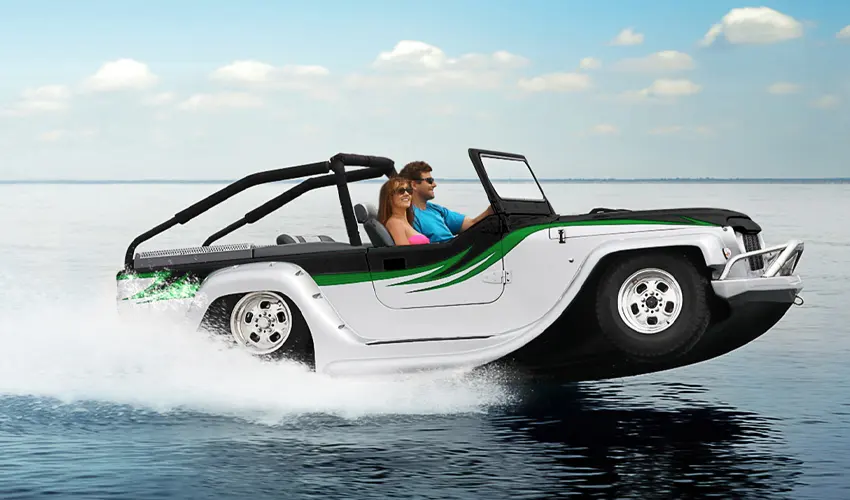
Throughout history, mankind has been fascinated by the idea of conquering both land and water with a single vehicle. Amphibious cars, also known as amphibious vehicles or a ‘Boat car’. These vehicles have emerged as remarkable creations that seamlessly transition between these two elements. In this in-depth article, we will explore the concept of amphibious cars. We also delve into their engineering feats, and highlight some of the most famous amphibious cars in the world.
Concept of Amphibious cars: The Allure of Amphibians
An amphibious car is designed to operate efficiently on both land and water, offering a unique transportation experience. The concept of these vehicles stems from the desire for versatility and the ability to traverse diverse terrains, including lakes, rivers, and even oceans.
Amphibious cars embody the convergence of innovation, technology, and adventure. These unconventional vehicles combine the principles of automotive and maritime engineering.

Amphibious vehicle: Technical challenges
Creating a vehicle that seamlessly transitions between land and water presents significant engineering challenges. Designers and engineers must address buoyancy, propulsion, stability, and structural integrity to ensure a safe and efficient operation in both environments.
An amphibious car features a combination of marine propulsion systems, waterproof seals, and specialized body designs. The combination of these factors enable them to navigate through water while maintaining functionality on land.
Famous amphibious cars: Making waves in pop culture
There are several automakers who have collaborated with marine companies to produce some of the most sophisticated boat cars. Therefore, we have listed out the 5 best amphibious cars:
- Amphicar Model 770
- Gibbs Aquada
- WaterCar Panther
- Rinspeed Splash
- Dutton Surf
Amphicar Model 770
The Amphicar Model 770, produced in the 1960s, is perhaps the most iconic amphibious car in history. With its distinctive design and innovative features, the Amphicar became a symbol of recreational amphibious vehicles.
It could reach speeds of up to 7 knots on water and 70 mph on land, captivating the imagination of many.
Gibbs Aquada
The Gibbs Aquada gained worldwide attention when Sir Richard Branson, the British entrepreneur, famously drove it across the English Channel in 2004.
This high-performance amphibious sports car reached speeds of up to 30 knots on water and 100 mph on land, showcasing the remarkable capabilities of modern amphibious technology.
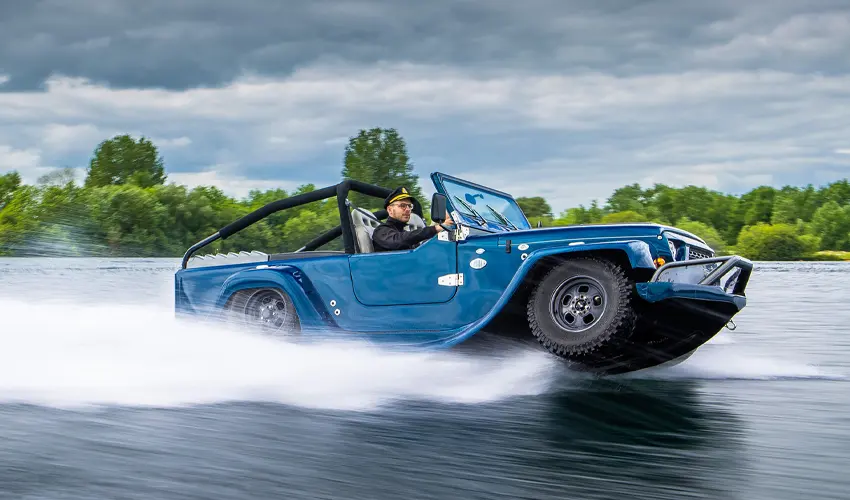
WaterCar Panther
The WaterCar Panther is a versatile amphibious vehicle designed for both off-road adventures and aquatic exploration. It boasts a powerful engine, rugged construction, and marine-grade propulsion, enabling it to seamlessly transition between various terrains.
Rinspeed Splash
The Rinspeed Splash is an impressive concept car that combines cutting-edge technology and aerodynamic design. With a hydrofoil system, it can raise its body above water to achieve high speeds while reducing drag.
The Rinspeed Splash demonstrates the limitless possibilities of amphibious car innovation.
Dutton Surf
The Dutton Surf is a renowned amphibious vehicle known for its simplicity and versatility. Designed and manufactured by Tim Dutton, this compact car boasts impressive amphibious capabilities.
Its lightweight construction and compact size make it agile both on land and water. With a top speed of around 80 mph on land and 10 mph on water, the Dutton Surf offers a thrilling and unique driving experience.
It has gained popularity among adventure seekers and enthusiasts who appreciate its practicality and fun factor.
Boat car, beyond recreation: Practical applications of amphibious cars
Amphibious cars have not only captured the imagination of enthusiasts but have also found practical applications in various industries.
From military operations and search-and-rescue missions to flood response and eco-tourism, these vehicles offer unique capabilities that conventional land or water vehicles cannot match.
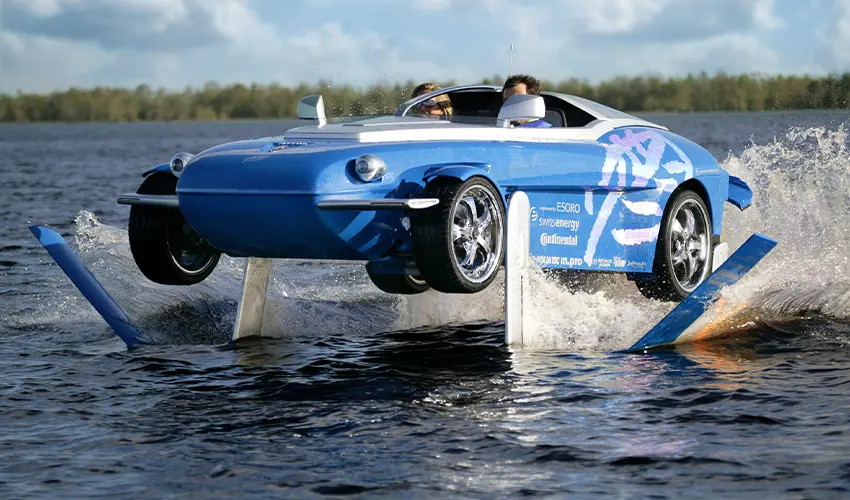
Their versatility and adaptability make them valuable assets in situations that require efficient mobility across different terrains.
Amphibious car functioning
Amphibious cars are probably the most sophisticated vehicles, based on their ability to travel on both land and water. Let’s delve into the mechanics behind amphibious cars and explore the key components and technologies that make them incredibly complex.
A dual-purpose design
Amphibious cars feature a specialized body design that accounts for both land-based mobility and aquatic performance. These vehicles typically incorporate a lightweight yet durable construction to ensure buoyancy in water and structural integrity on land.
The streamlined shape helps reduce drag and improve hydrodynamics when the car is in water, enabling smoother movement.
Marine propulsion systems
To propel an amphibious car in water, it requires a reliable marine propulsion system. Most amphibians employ water propulsion mechanisms such as water jets, propellers, or paddle wheels.
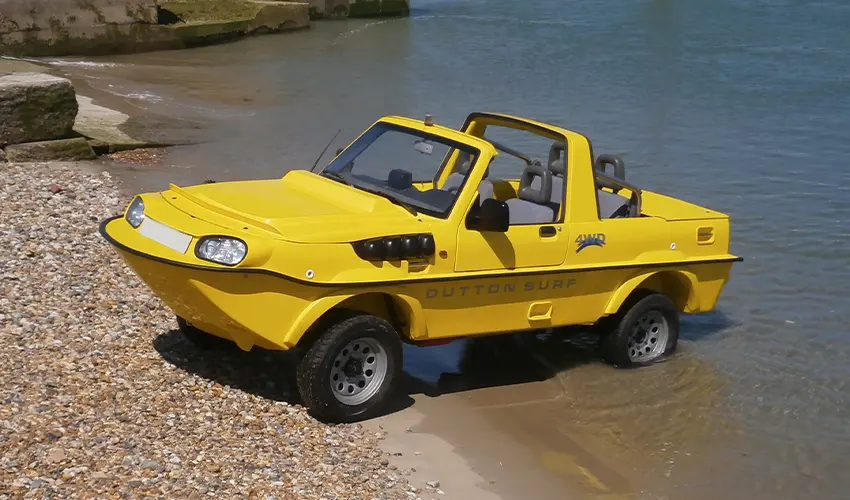
These systems harness the power of water to propel the vehicle forward, much like a traditional boat or watercraft. The propulsion system is carefully integrated into the design, ensuring efficiency and maneuverability in aquatic environments.
Land-based propulsion
When transitioning to land, amphibious cars rely on conventional automotive propulsion systems. Typically equipped with gasoline or diesel engines, these vehicles utilize wheels or tracks for terrestrial movement.
The powertrain and drivetrain are designed to deliver optimal performance on different surfaces, ensuring smooth transitions between land and water.
Waterproof seals
Amphibious cars must have robust waterproof seals to prevent water from entering the vehicle’s critical components. These seals are strategically placed throughout the body, including doors, windows, and hatches, to maintain a watertight interior when the car is submerged or partially immersed.
Advanced sealing technologies, such as rubber gaskets and specialized adhesives, ensure effective water resistance.
Retractable wheels
One of the essential features of amphibious cars is the ability to retract or raise the wheels when entering water.
This process is often automated, using hydraulic or mechanical systems that tuck the wheels into the body, reducing drag and allowing the vehicle to float.
Once back on land, the wheels extend or lower, enabling normal terrestrial operation.
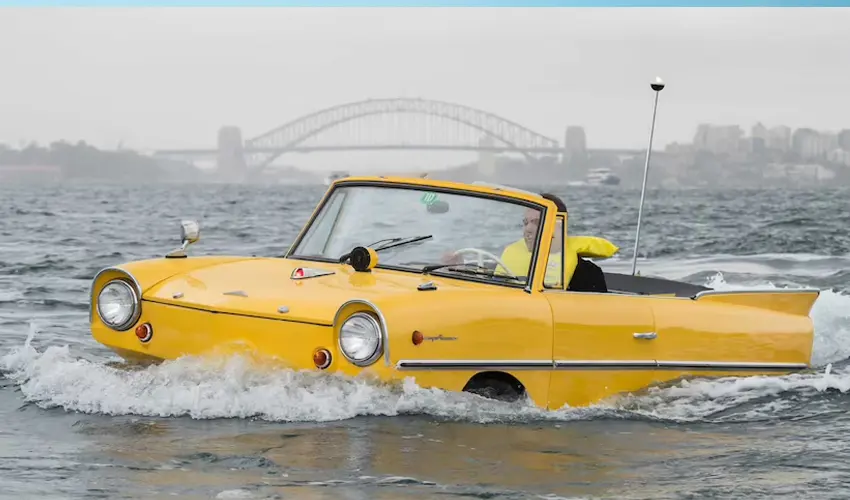
Buoyancy and stability
Amphibious cars incorporate buoyancy control systems to ensure stability in water. These systems utilize buoyancy chambers or compartments that can be flooded or emptied to adjust the vehicle’s buoyancy level.
By regulating the amount of water within these compartments, the car can achieve optimal balance and stability, preventing tilting or capsizing while navigating through water.
Safety features
Amphibious car designers prioritize safety in their designs. These vehicles often include safety features like life jackets, emergency floatation devices, and enhanced stability controls to mitigate risks associated with water travel.
Additionally, amphibious cars undergo rigorous testing to meet safety standards and regulations for both automotive and marine industries.
Amphibious car: When innovation meets creativity
Amphibious cars represent the harmonious integration of automotive and maritime engineering. These cars offer an unparalleled transportation experience that seamlessly bridges the gap between land and water.
Through remarkable design, engineering prowess, and the spirit of adventure, a boat car can captivate the world and continue to inspire innovation in the automotive industry.
As technology evolves, we can expect to see even more advanced and extraordinary amphibious cars that redefine our perception of mobility and exploration.

-

 Informative3 years ago
Informative3 years ago21 Amazing Fruits That Are Not Round
-

 Science3 years ago
Science3 years agoHow To Make a Dry Ice Bomb at Home? Risks and Precautions
-

 How to3 years ago
How to3 years agoHow to Put a Tampon On: Step by Step Guide
-

 How to3 years ago
How to3 years agoHere’s How to Know When The Oil Cartridge Is Empty
-

 Informative3 years ago
Informative3 years agoElf Ear Surgery: Cost, Procedure, and Risks
-

 How to3 years ago
How to3 years agoFixed: The Torrent You Are Trying To Add is Already in The List
-

 How to3 years ago
How to3 years agoHow To Thaw Frozen Pipes Underground
-

 How to3 years ago
How to3 years agoSolved: How to Change Your Age on TikTok? (2021)